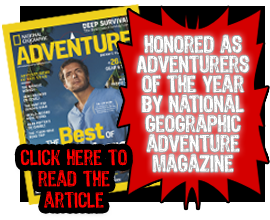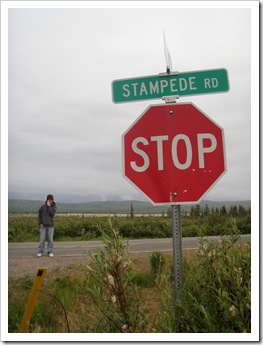
Off in the distance were rapids. The Teklanika River raged. The volume and force of the water was powerful. There was nothing that could be done. We were 16 miles out on the Stampede Trail, now called the Stampede Road, 8 miles from the “Into The Wild†bus, and there was nothing we could do. Craig, with a rope tied around his waist, attempted to wade across, but to no avail. It could not be done.
My eyes looked across the river and I envisioned Christopher McCandless, who years previous, was unable to cross this same river, forcing him to return to the bus in which he was living. I felt for him. I could not even imagine the feeling he felt, coming up to the river, trying to get out, and then not being able to. That sense of helplessness, of not being able to continue on, is more than terrible, and I could see why he went back to the only place he knew out there, the bus.
Christopher McCandless’ story is one of intrigue and mystery. People debate many points of his story, and many have very strong opinions on the matter. To each their own, and everyone is entitled to them, but I think there are lessons to be learned from this story, which is one of the reasons we headed to Healy, Alaska.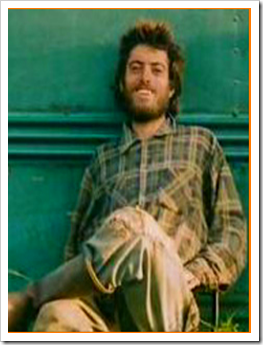
McCandless’ story spans from a rough childhood with a lot of family issues, to a college graduation, to donating his entire savings to charity, to criss-crossing the nation trying to find adventure, himself, and to explore nature by the means of California, Arizona, South Dakota and finally Alaska, where he got his chance to live simply in the wild. It was here that he hitched a ride on the Stampede Road, and hiked into the wilderness in April of 1992. His sense of adventure, the sense of not conforming to “everyday†structure of things, and his sense to break out of his comfort zone is something that I believe a lot of us admire. He lived in an old abandoned bus from April to August in the Alaskan wilderness, with very little supplies, surviving off the land, and was able to document his experience with journal entries and self-photographs. His intention was to cross back across the Teklanika River in July of 1992, but was deterred by the raging river, which forced him back to the bus. His body was subsequently found a couple months later in the beginning of September in his sleeping bag, with starvation being the official cause of death, but speculation arises on the exact cause, with some believing it was a result of a poisonous potato seed.
On August 12, according to Outside Magazine, McCandless wrote what are assumed to be his final words in his journal: “Beautiful Blueberries.” He tore the final page from Louis L’Amour’s memoir, Education of a Wandering Man, which contains an excerpt from a Robinson Jeffers poem titled “Wise Men in Their Bad Hours”:
-
Death’s a fierce meadowlark: but to die having made
-
Something more equal to centuries
-
Than muscle and bone, is mostly to shed weakness.
-
The mountains are dead stone, the people
-
Admire or hate their stature, their insolent quietness,
-
The mountains are not softened or troubled
-
And a few dead men’s thoughts have the same temper.
On the other side of the page, McCandless added, “I HAVE HAD A HAPPY LIFE AND THANK THE LORD. GOODBYE AND MAY GOD BLESS ALL!”
His experience, no matter how you take it, brought about a book (Into the Wild, by Jon Krakauer), a movie (Into the Wild, film by Sean Penn), a documentary (Call of the Wild, film by Ron Lamothe), controversy, pilgrimages to his final resting place, and many discussions on what he stood for, who he was, what he did, and made many people take a good, hard look inside themselves. The vastness of this rarely happens, but unfortunately noted, is the fact that many times its the result of a tragedy. On that day, at that time, he made his decision and walked down the Stampede Road, into the wild.
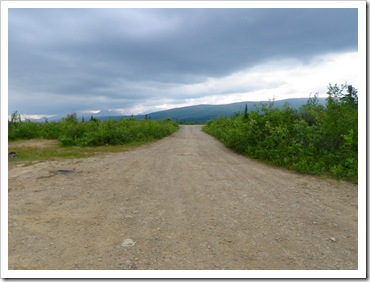 He began his trek on the Stampede Road 17 years ago, and would have had to walk right by Coke Wallace’s place, the last place on the road at that time. Wallace was living in a wall tent, and as he said, “I must have just missed the kid walking by, as I was probably putting up fence posts.â€
He began his trek on the Stampede Road 17 years ago, and would have had to walk right by Coke Wallace’s place, the last place on the road at that time. Wallace was living in a wall tent, and as he said, “I must have just missed the kid walking by, as I was probably putting up fence posts.â€
With the help of Craig, I was able to make the contact with Coke Wallace, an experienced hunter/trapper/guide, and owner of Midnight Sun Safaris in the Healy area, who still lives on the same piece of property. The majority of his business is guided hunting tours and trapping, but he occasionally brings people out to see the bus.  He was an incredible person to get first hand information from, chat with, hear stories from, and get a guided trip from. We loaded up his Polaris 6X6 Ranger, and attempted our journey to the bus. He had warned us from the start that his buddy had said the Teklanika River was raging, but was willing to check it out, for which we were very grateful. The bus is 26 miles from his doorstep, and the Teklanika River, the troublesome spot, was 18 miles down the road/trail.
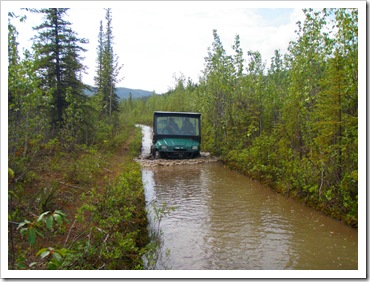 Coke skillfully maneuvered his tough as nails Polaris Ranger through where he believed McCandless was initially dropped off (pictured above), small creeks, mud bogs, and swamps along the narrowing trail. We successfully crossed the Savage River, but a bit further down encountered the mighty Teklanika River, which would be as far as we would get. It was so close, but yet so far away. The bus, only 8 miles now away, was up over the ridge that was right in front of us. The toughest ATV I’ve ever seen, and even a beyond adventurous/no water fearing Craig, had to bow down to the whims of Mother Nature.
Coke skillfully maneuvered his tough as nails Polaris Ranger through where he believed McCandless was initially dropped off (pictured above), small creeks, mud bogs, and swamps along the narrowing trail. We successfully crossed the Savage River, but a bit further down encountered the mighty Teklanika River, which would be as far as we would get. It was so close, but yet so far away. The bus, only 8 miles now away, was up over the ridge that was right in front of us. The toughest ATV I’ve ever seen, and even a beyond adventurous/no water fearing Craig, had to bow down to the whims of Mother Nature.
Lessons are sometimes easily found in hindsight, which by no means am I degrading McCandless, but just using his experience to try to help that of others. It was here, on the banks of the river, that one of the biggest lessons was seen firsthand that one has to truly be prepared to do battle with Mother Nature. Just as Coke said, “Rivers out here can change by the hour. In the morning I’ll wade it calf deep and then come back in the afternoon to come back across and its up to my chest. You just never know, and got to be aware.â€Â Being prepared is essential, especially in dire conditions. Testing one’s self gets a person close to their limits, but one has to be aware of that line, with deadly consequences a possible result if that line is broke. Problems, hard times and family issues find their place in all of our lives, with each person dealing with them in different ways. Running from them, as many of us do, rarely ever finds its solution. Taking an issue head on and getting it resolved may be tough, but it can be done. Youthful souls, as well, sometimes don’t realize the hearts they effect in their actions. Make sure to make people aware of where you’re at, and tell the people around you how much they mean to you, for one never knows when that time, may be your last.
Â
Photos:
Â
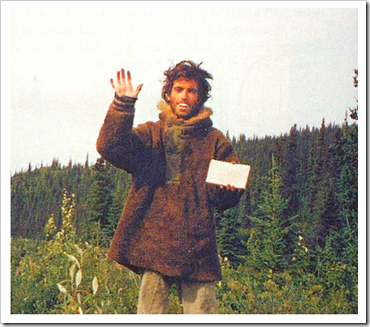
Christopher Johnson McCandless, one of his last photographs
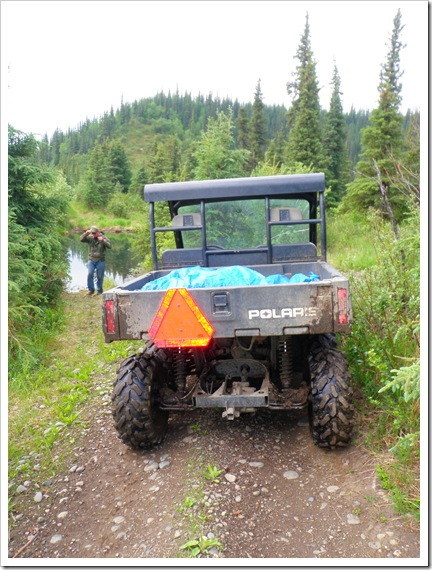
Coke Wallace and his Polaris Ranger 6X6
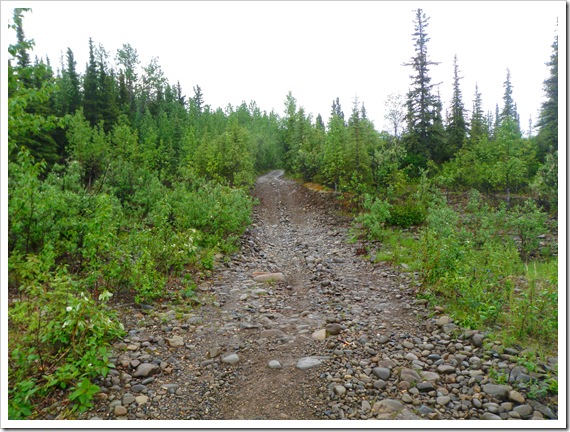
Stampede Road
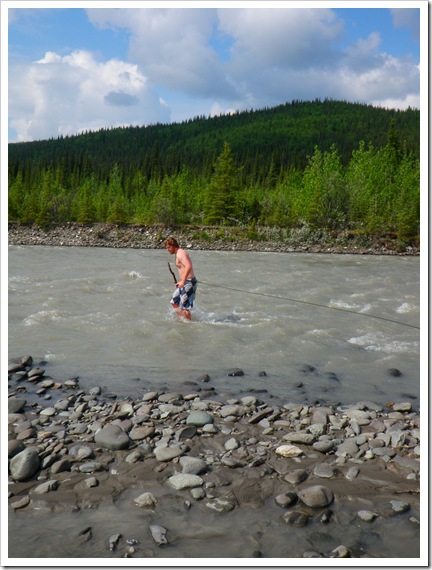
Craig, tied at the waist, begins his attempt to cross the Teklanika River
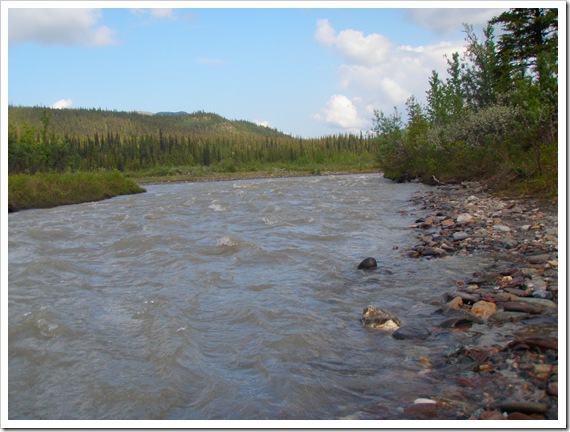
A place a little upstream where Coke sometimes can cross with his ATV, obviously not today with the river in this condition
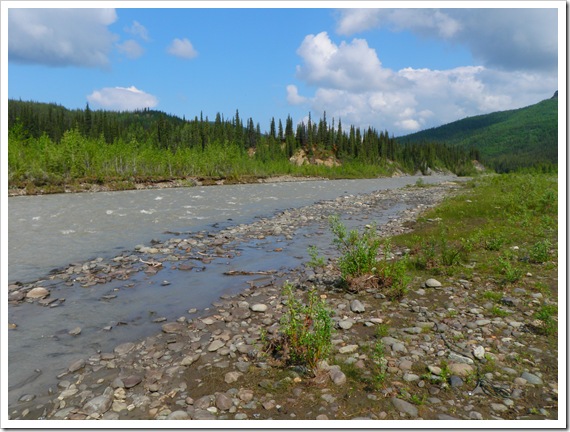
As far as we could make it, next to mighty Teklanika River
INSERT_MAP

































































































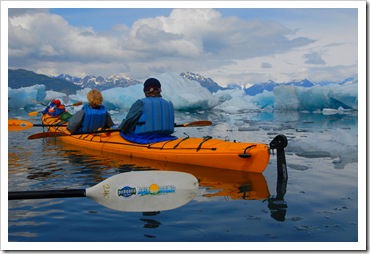 ts Jerry and Susie. We had some great meals and conversations with them, and were beyond lucky that they had an abundance of halibut. Home cooked meals are never taken for granted by anyone on the crew. We were also fortunate enough to participate in two stellar activities in Valdez. The first was done by the other crew members as they ventured out within the Columbia Glacier sea kayaking with
ts Jerry and Susie. We had some great meals and conversations with them, and were beyond lucky that they had an abundance of halibut. Home cooked meals are never taken for granted by anyone on the crew. We were also fortunate enough to participate in two stellar activities in Valdez. The first was done by the other crew members as they ventured out within the Columbia Glacier sea kayaking with 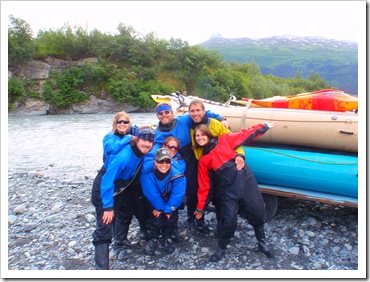
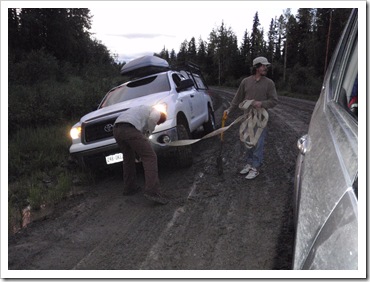 Yet another long day of driving resulted in a crazy end of the day. Tired and weary we turned off the highway to find a place to camp. It was a gas company road, but also had a sign for camping. It did, however, have another sign that said that trucks during the muddy or snowy season should have chains. The adventure began. I was in the passenger seat of the follow car, with Miss Magnuson driving the Tundra in front of us. The road was less than stable. “OH, NO!,†gasped Miss Hodge from the backseat of the Sequoia as the Tundra slowly made it’s way into the ditch. At an angle, almost ready to tip over, was the tough Tundra. Out of the truck popped a crazy-haired Shoppman, with a huge grin on his face as he stated, “Welcome to Africa, my friends, it’s been awhile since I’ve had to do this.â€Â “Game on,†I thought, “here we go.â€Â We rigged up a tow rope, got Craig rocking in the Sequoia, and had Shoppman battling with the Tundra. After a little bit of a struggle we came out victorious, and got both vehicles to somewhat safe ground. We found the campsite, pondered yet another memorable adventure on the road, and sat around the fire together for dinner at 1 in the morning.
Yet another long day of driving resulted in a crazy end of the day. Tired and weary we turned off the highway to find a place to camp. It was a gas company road, but also had a sign for camping. It did, however, have another sign that said that trucks during the muddy or snowy season should have chains. The adventure began. I was in the passenger seat of the follow car, with Miss Magnuson driving the Tundra in front of us. The road was less than stable. “OH, NO!,†gasped Miss Hodge from the backseat of the Sequoia as the Tundra slowly made it’s way into the ditch. At an angle, almost ready to tip over, was the tough Tundra. Out of the truck popped a crazy-haired Shoppman, with a huge grin on his face as he stated, “Welcome to Africa, my friends, it’s been awhile since I’ve had to do this.â€Â “Game on,†I thought, “here we go.â€Â We rigged up a tow rope, got Craig rocking in the Sequoia, and had Shoppman battling with the Tundra. After a little bit of a struggle we came out victorious, and got both vehicles to somewhat safe ground. We found the campsite, pondered yet another memorable adventure on the road, and sat around the fire together for dinner at 1 in the morning.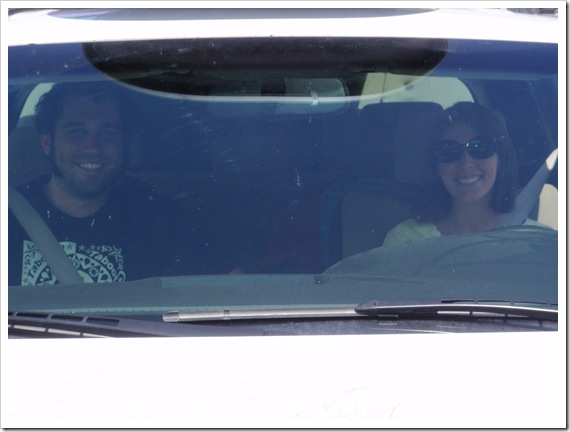 The Hungarian takes the wheel, smiles all around
The Hungarian takes the wheel, smiles all around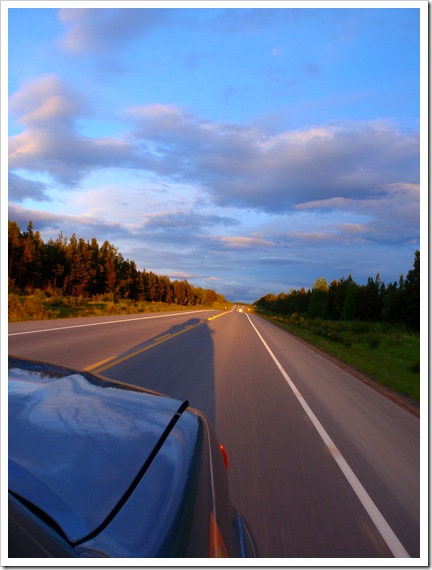


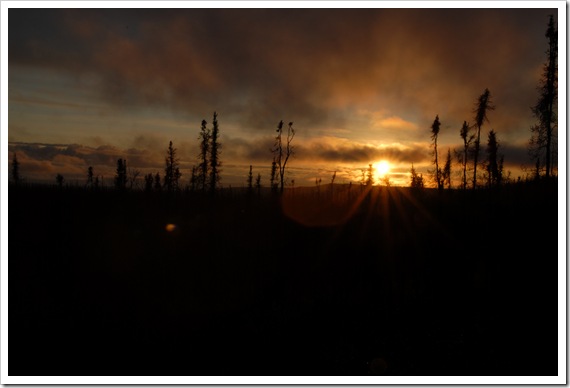

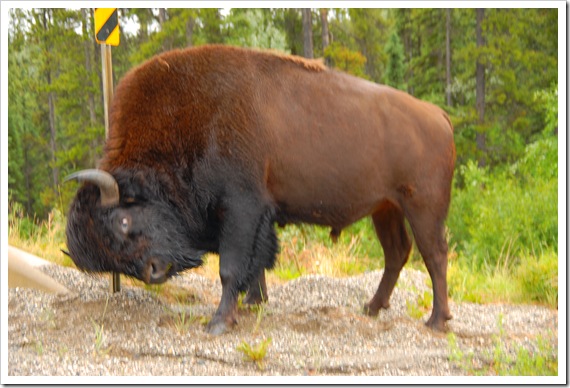
 One month ago we set out from Denver for the great wide open wilderness of Alaska. Before leaving, Craig and I conducted considerable research on the last section of road to Prudhoe Bay named the James W. Dalton highway. I found a website with an entire page devoted to the road named
One month ago we set out from Denver for the great wide open wilderness of Alaska. Before leaving, Craig and I conducted considerable research on the last section of road to Prudhoe Bay named the James W. Dalton highway. I found a website with an entire page devoted to the road named  Then came reality. About 20 miles in, the road went back to pavement. For the next 500 miles it did the same, going back and forth to gravel and pavement. While it was no small feat of a journey, it certainly was not the picture that had been painted in my head. The roads are clearly beaten down by the overloaded trucks, constantly moving permafrost, –70 temperatures in the winter, and the regular precipitation. This leaves a varying degree of smoothness from new pavement to giant whooping dips that could send you airborne into the soggy earth lining the sides of the road. After the first 200 miles, it seemed likely, the road beyond Coldfoot would prove to be the bad part. After Coldfoot, the road did not really change, but the loneliness quickly set in.
Then came reality. About 20 miles in, the road went back to pavement. For the next 500 miles it did the same, going back and forth to gravel and pavement. While it was no small feat of a journey, it certainly was not the picture that had been painted in my head. The roads are clearly beaten down by the overloaded trucks, constantly moving permafrost, –70 temperatures in the winter, and the regular precipitation. This leaves a varying degree of smoothness from new pavement to giant whooping dips that could send you airborne into the soggy earth lining the sides of the road. After the first 200 miles, it seemed likely, the road beyond Coldfoot would prove to be the bad part. After Coldfoot, the road did not really change, but the loneliness quickly set in. off in good spots to let the “18 wide by 150 longs†pass. So while it was not the exciting near death passes anticipated, it was a great lesson in speaking truck after using the CBs more for these 500 miles than any other part of the expedition.
off in good spots to let the “18 wide by 150 longs†pass. So while it was not the exciting near death passes anticipated, it was a great lesson in speaking truck after using the CBs more for these 500 miles than any other part of the expedition. That night, if it can be called that with a full sun in the sky, ended with a drive back out of town to a frozen bog next to a ice-chunk filled river where we cracked a celebratory bottle of wine while shivering while setting up tents. Earlier from our research, we found it was to be a full moon, but the bright sun drowned out any sightings of the moon while the freezing Arctic winds ripped through our clothes. However, still was a nice way to finish, knowing the moon was up there somewhere sharing the sky with the sun. Nothing could bring us down as no victory after a near two and a half year struggle across 69 borders can be soured. While Deadhorse proved to be quite possibly the worst place over the entire 80,000 mile journey, the midnight sun in this alien land cast an excellent light over our final triumphant cheers to the last frontier of our journey
That night, if it can be called that with a full sun in the sky, ended with a drive back out of town to a frozen bog next to a ice-chunk filled river where we cracked a celebratory bottle of wine while shivering while setting up tents. Earlier from our research, we found it was to be a full moon, but the bright sun drowned out any sightings of the moon while the freezing Arctic winds ripped through our clothes. However, still was a nice way to finish, knowing the moon was up there somewhere sharing the sky with the sun. Nothing could bring us down as no victory after a near two and a half year struggle across 69 borders can be soured. While Deadhorse proved to be quite possibly the worst place over the entire 80,000 mile journey, the midnight sun in this alien land cast an excellent light over our final triumphant cheers to the last frontier of our journey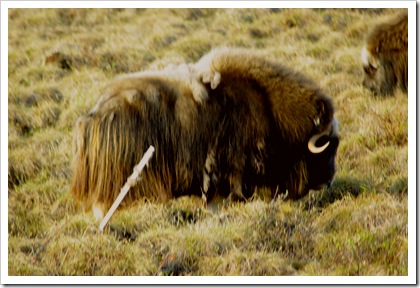 The summit of the pass lead us to the North Slope and all the animals that live there including Caribou and the funky Musk Ox that looks like a buffalo wearing a robe. Very few people live along this road, but those that do had already read the article about us in the Fairbanks News Miner before we started the journey back, so our successful journey had us received in Coldfoot and Fairbanks like stars. Unlike our un-climactic cross of the US border into Houston, this milestone produced a sense that the journey meant something to the community that surrounded us. Stops at coffee stands and truck stops granted free cups of coffee and cheers from those who knew we had just accomplished a great feat. “You are those world adventurers,†said the enthusiastic staff at the front desk of the Pikes lodge that hosted us on our return. They agreed to give us a congratulations dinner on the house, and later the waitress confessed that she was nervous to serve the stars she had read about in the paper a few days prior. The reception of these kind people put the icing on the cake for an expedition finale to remember.
The summit of the pass lead us to the North Slope and all the animals that live there including Caribou and the funky Musk Ox that looks like a buffalo wearing a robe. Very few people live along this road, but those that do had already read the article about us in the Fairbanks News Miner before we started the journey back, so our successful journey had us received in Coldfoot and Fairbanks like stars. Unlike our un-climactic cross of the US border into Houston, this milestone produced a sense that the journey meant something to the community that surrounded us. Stops at coffee stands and truck stops granted free cups of coffee and cheers from those who knew we had just accomplished a great feat. “You are those world adventurers,†said the enthusiastic staff at the front desk of the Pikes lodge that hosted us on our return. They agreed to give us a congratulations dinner on the house, and later the waitress confessed that she was nervous to serve the stars she had read about in the paper a few days prior. The reception of these kind people put the icing on the cake for an expedition finale to remember.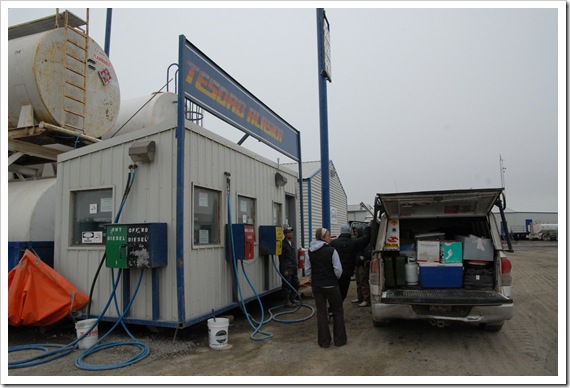

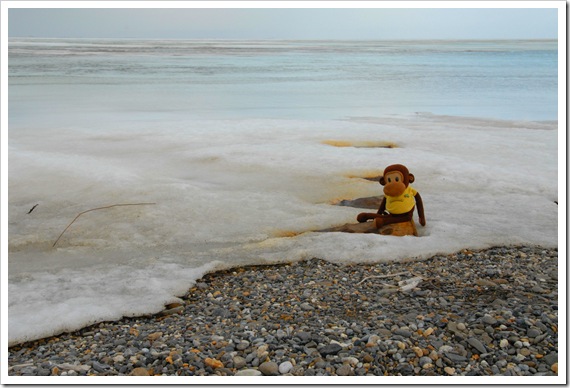




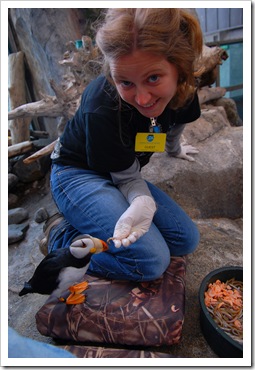
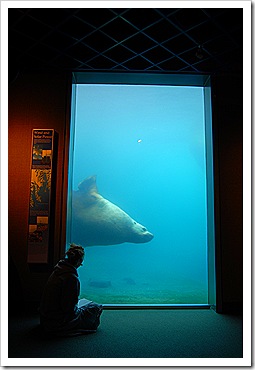
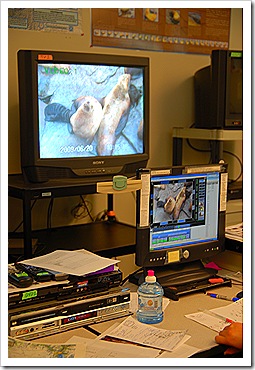
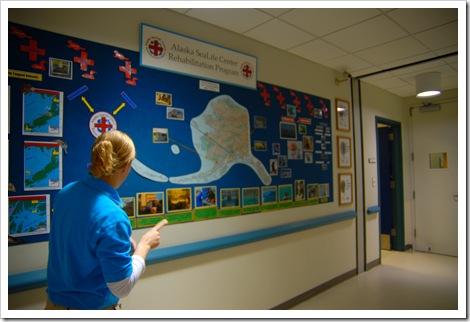
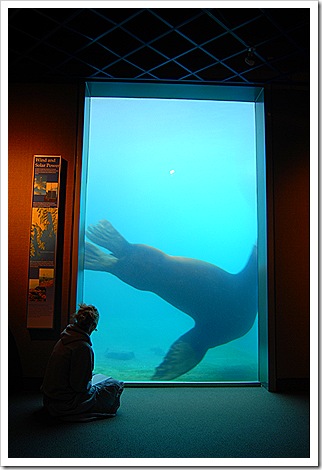
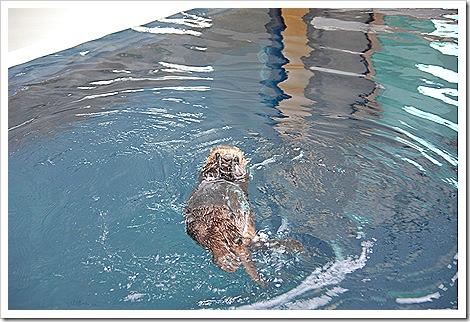
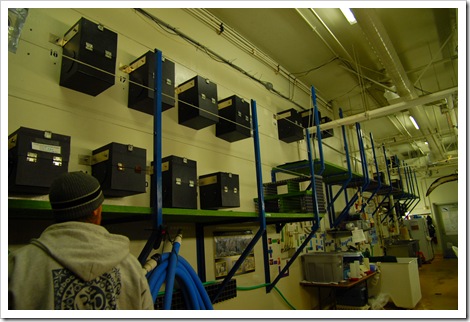
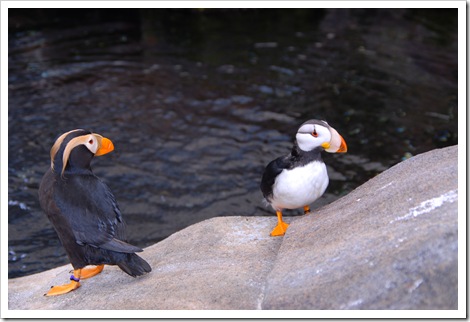
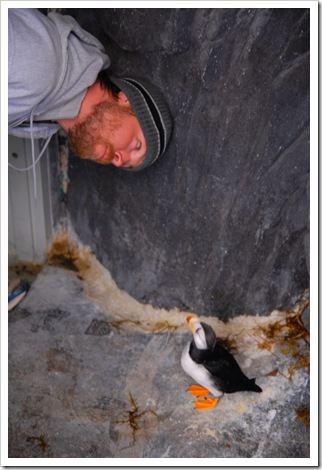
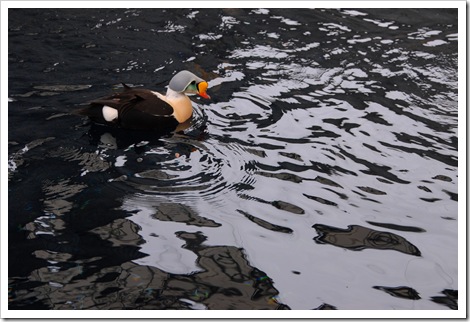
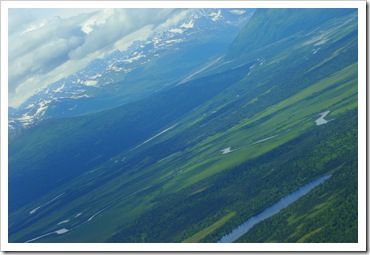
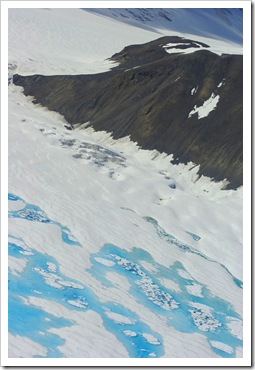
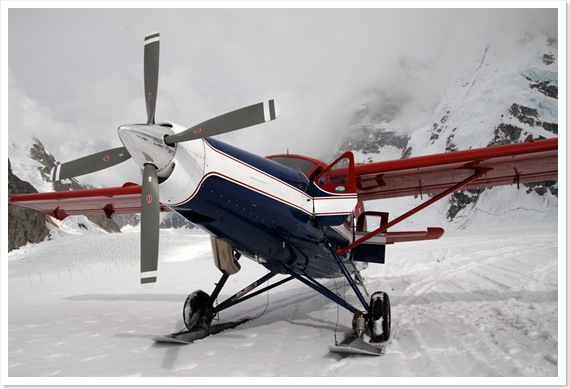
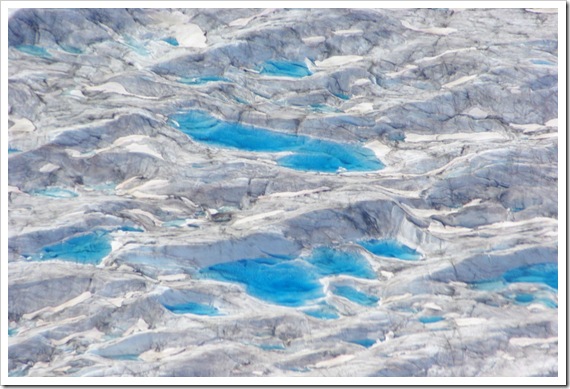
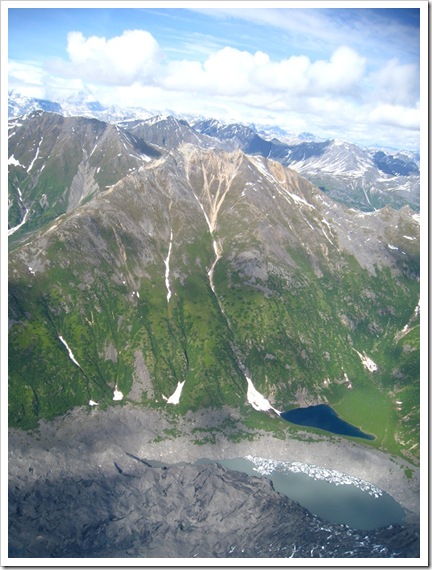
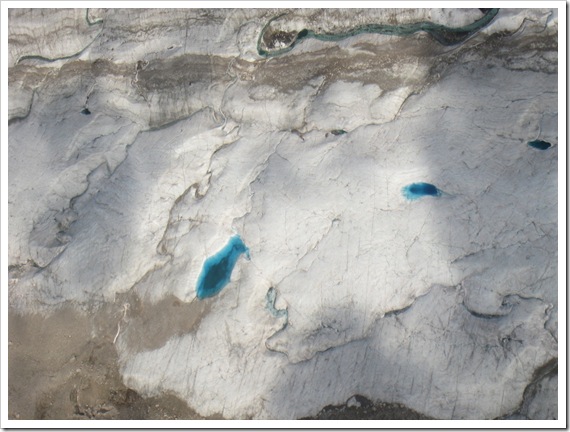
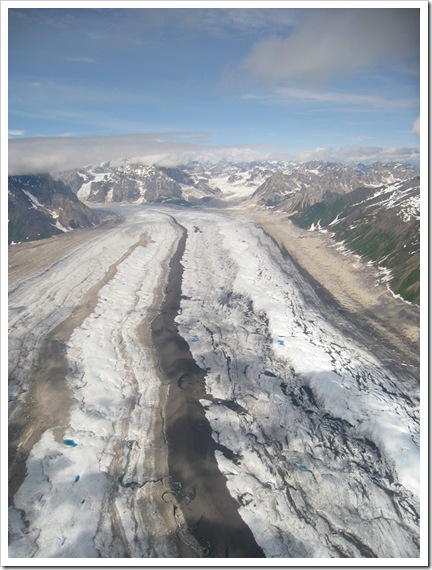
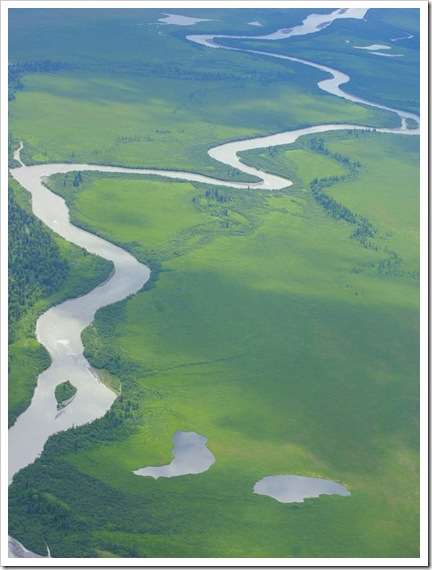
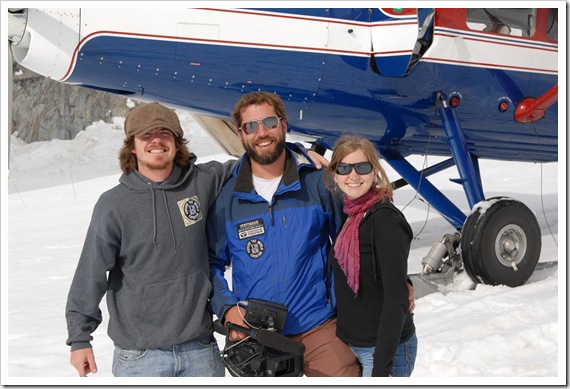
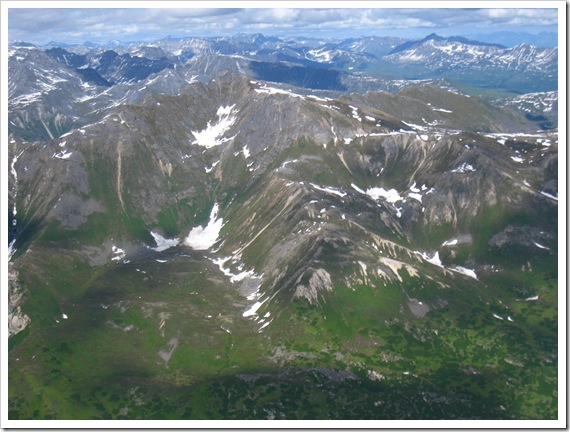
 We’ve really enjoyed ourselves in Alaska, and all feel very fortunate for all that we’ve been able to see, experience, and the people we’ve been able to meet, so it was nice that we got to give back a little this week, as well. It has been another great stretch of days in the northern most state. It began with a great lake and river kayaking trip/fly fishing trip with
We’ve really enjoyed ourselves in Alaska, and all feel very fortunate for all that we’ve been able to see, experience, and the people we’ve been able to meet, so it was nice that we got to give back a little this week, as well. It has been another great stretch of days in the northern most state. It began with a great lake and river kayaking trip/fly fishing trip with  The following morning brought us to the
The following morning brought us to the  y Fishing.
y Fishing.

 He began his trek on the Stampede Road 17 years ago, and would have had to walk right by Coke Wallace’s place, the last place on the road at that time. Wallace was living in a wall tent, and as he said, “I must have just missed the kid walking by, as I was probably putting up fence posts.â€
He began his trek on the Stampede Road 17 years ago, and would have had to walk right by Coke Wallace’s place, the last place on the road at that time. Wallace was living in a wall tent, and as he said, “I must have just missed the kid walking by, as I was probably putting up fence posts.â€ Coke skillfully maneuvered his tough as nails Polaris Ranger through where he believed McCandless was initially dropped off (pictured above), small creeks, mud bogs, and swamps along the narrowing trail. We successfully crossed the Savage River, but a bit further down encountered the mighty Teklanika River, which would be as far as we would get. It was so close, but yet so far away. The bus, only 8 miles now away, was up over the ridge that was right in front of us. The toughest ATV I’ve ever seen, and even a beyond adventurous/no water fearing Craig, had to bow down to the whims of Mother Nature.
Coke skillfully maneuvered his tough as nails Polaris Ranger through where he believed McCandless was initially dropped off (pictured above), small creeks, mud bogs, and swamps along the narrowing trail. We successfully crossed the Savage River, but a bit further down encountered the mighty Teklanika River, which would be as far as we would get. It was so close, but yet so far away. The bus, only 8 miles now away, was up over the ridge that was right in front of us. The toughest ATV I’ve ever seen, and even a beyond adventurous/no water fearing Craig, had to bow down to the whims of Mother Nature.





